He was chosen by Obama not because he is strong, independent of mind and competent but because he is weak and malleable. Obama will manipulate this lap dog and weaken our military capabilities because Obama is a darker version of Chamberlain! (See 1 below)
---
According to Bullard, The Fed will stimulate for quite bit longer. (See 2 below)
---
Keynesian Depression. The author validates my thinking and where I believe we are headed. Timing is the only uncertainty, not the inevitability.(See 3 below.)
---
Dick
---------------------------------------------------------------------------------------------------------------------------------------------------
1)What the 'Lobby' Knows About Animus for Israel
By: Ruth R. Wisse
The Jewish state, as the 'little Satan,' is a stand-in for the 'big Satan' and Western values
The confirmation process for those slated to guide American foreign policy can profitably be used to clear up at least one point of confusion. What's at issue is not the degree of their affection for Jews or for Israel—despite the consternation caused by the nomination for defense secretary of Chuck Hagel, who said in 2006: "The Jewish lobby intimidates a lot of people up here, but I'm a United States senator. I'm not an Israeli senator."
The Nebraskan's imputation of excessive Jewish influence in Washington is less worrisome than his failure to recognize why the "lobby" exists. Never mind the Jews: Opposition to Israel camouflages a much more virulent hostility to America. How does an American statesman assess the anti-Jews who attack Israel as a proxy for this country?
Let's start with basics: The cause of the long-running Arab war against the Jewish homeland is not Israel, it is Arab leaders' need for war against a "foreign intruder." Seven Middle East countries rallied their citizens by forming the Arab League in 1945 to prevent the creation of Israel. Failing in that effort, the Arab League eventually expanded to 21 members, which organized their domestic and foreign politics against the Jewish state. When Anwar Sadat signed a peace treaty with Israel in 1979, Egypt was suspended from the league, expelled from the Islamic Conference and ousted from other regional and financial institutions. Re-admission for Egypt came only after the assassination of Sadat and his successor's abrogation of almost every term of the treaty.
Opposition to Israel is the only glue of pan-Arabism and the strongest common bond of otherwise warring Muslim constituencies.
Even those inclined to end the war are afraid of the consequences (including assassination) of giving up hostilities.
Like the anti-Semitism from which it derives, anti-Zionism is less about the Jews than about the larger aims of those aggressing against the Jews. When the League of Anti-Semites formed in Germany in the 1870s, its primary goal was to prevent the spread of liberal democracy. Rather than denounce a freer, more open society, the league called democracy the ruse that allowed Jews to conquer Germany from within.
In the same way, anti-Zionism today unites conservatives and radicals in the Middle East against all that Israel represents—religious pluralism, individual rights and freedoms, liberal democracy, and Western ideas of progress. Jews and Israel are merely a convenient face or emblem for the huger bastions of those same ideals. Israel, "little Satan," is a handier target than the "big Satan."
The Arab war against Israel has cost thousands of Jewish lives, but its damage to Palestinians is arguably greater, destroying the moral fabric of a society that was once relatively prosperous and culturally advanced. Anti-Jewish politics works by misdirection, drawing attention away from real concerns toward the alleged Jewish violator. Thus, Arab leaders who tried to deny Jews their country accused Jews of denying Arabs their country.
To make the charge stick, the leaders have kept Palestinian Arabs in perpetual refugee status while millions of other refugees around the world—including 800,000 Jews from Arab lands—were resettled and started their lives anew.
Many societies have identified Jews as the threatening alien, but Palestinian Arabs are the first people ever to shape their national identity exclusively around opposition to the Jews. The special ingredient that sets Palestinian nationalism apart from that of surrounding Syria, Lebanon, and Jordan—and reputedly makes it the strongest form of Arab nationalism—is the usurpation of Jewish symbols and history. The most important date in the Palestinian calendar is not any Arab or Muslim holiday or event, but the day of Israel's founding, commemorated as Nakba, the catastrophe that ostensibly spurred the creation of Arab Palestine. Commemorated as "Palestine's endless Holocaust," Nakba simultaneously libels the Jewish homeland and demeans the Shoah by appropriating the Nazi genocide of Europe's Jews.
A new logo for the Palestinian political party Fatah claims the entire map of Israel. Fatah's rival, Hamas, is led by Khalid Mashaal, who recently called for the liberation of "Gaza today and tomorrow Ramallah and after that Jerusalem then Haifa and Jaffa." Clearly, both factions remain more intent on destroying their neighbor than on bettering Palestinian lives.
A perfumer in Gaza has named his new fragrance "M-75" after the "pleasant and attractive" missiles used by Hamas to attack Israel. A Facebook page for Fatah shows a mother strapping her child into a suicide belt; when he asks his mother why him and not her, the mother says that she must bear more children to sacrifice for Palestine. Civil war in Syria, turmoil in Egypt, crisis in Iran and an Islamist threat to Jordan—all follow from the same ruinous politics of grievance and blame.
Chuck Hagel does not have to like Jews, but if he expects to defend the United States, he needs to understand the nature and scope of the war against Israel, including its corrupting effect on Arab societies. The alignment between Israel and America is dictated by those who burn the flags of both countries on the same pyre.
By contrast, those who lobby for Israel's protection axiomatically have America's back.
Ms. Wisse, a professor of Yiddish and comparative literature at Harvard, is the author of "Jews and Power" (Schocken, 2007).
--------------------------------------------------------------------------------------------------------------------------------
2)Bullard: Fed to Stay Easy Despite Exit Chatter
!
The Federal Reserve will keep its monetary policy stance loose for a long while despite increasing signs of concern among policymakers about the potential costs of asset buying, a top Fed official said on Friday.
"Fed policy is very easy and it's going to stay easy for a long time," James Bullard, St. Louis Fed president, said in an interview with CNBC television.
Minutes released from the U.S. central bank's policy meeting last month showed a number of officials think the Fed might have to slow or stop buying bonds before seeing the pickup in hiring which the program is designed to deliver. Bond buying is one of the key elements in the Fed's monetary stimulus.
Many analysts nevertheless think the Fed's leadership will determine the economic benefits of the maintaining the bond purchases for some time are likely to outweigh the financial risks.
Bullard, who has a vote this year on the Fed's policymaking Federal Open Market Committee (FOMC), has expressed caution about expanding the central bank's balance sheet too far. He has advocated scaling back the bond purchases as the labor market improves.
On Friday, Bullard acknowledged more voices within the FOMC are pressing to scale back bond buying. Some Fed members are concerned their easy monetary policy could soon fuel inflation.
"The idea of tapering the program at some point in the future may be gaining some steam on the committee," he said.
But Bullard also noted that the inflation rate is not threatening to breach the Fed's 2 percent target.
"The Fed has room to maneuver because of this," he said.
The Fed has more than tripled the size of its balance sheet since 2008 to around $3 trillion through a series of bond-buying programs. It opted in January to keep purchasing assets at an $85 billion monthly pace until the U.S. labor market outlook improved substantially.
In a policy shift late last year, the Fed committed to keeping interest rates near zero until the unemployment rate drops to 6.5 percent, as long as inflation is not forecast to go above 2.5 percent over a one- to two-year horizon. The jobless rate stood at 7.9 percent in January.
While many analysts expect the Fed to keep its bond-buying program in place throughout 2013, some worry this could fuel asset bubbles. Bond-buying programs in other countries are also seen as exacerbating this risk.
"I don't think they (in the Fed) are vigilant in terms of other central banks and their quantitative easing policies," Bill Gross, founder and co-chief investment officer of bond giant Pimco, told the same CNBC program. "And I don't think they are vigilant in terms of asset prices."
© 2013 Thomson/Reuters. All rights reserved.
-------------------------------------------------------------------------------------------------------------------------------------------------
3)
The Keynesian Depression
A Premonition From a Halcyon Era
By Scott Minerd, Chief Investment Officer, Guggenheim Funds
In 1968, America was literally over the moon. Apollo 7 had just made the first manned lunar orbit and the nation would soon witness Neil Armstrong’s moonwalk. The United States was winning the war in Southeast Asia and the Great Society was on the verge of eliminating poverty. I remember my father taking me to the Buick dealership that summer in Connellsville, Pennsylvania, where he bought a 1969 Electra. As we drove home I asked him why we had bought the 1969 model when we had the 1968 one, which seemed equally good.
“That’s just what you do now,” my father said, “Every year you go and get a new car.” “Wouldn’t it be better,” I asked as a precocious nine year-old, “if we saved our money in case a depression happened?” I will never forget my father’s reply: “Son, the next depression will be completely different from the one that I knew as a boy. In that depression, virtually nobody had any money so if you had even a little, you could buy nearly anything. In the next depression, everyone will have plenty of money but it won’t buy much of anything.” Little did I realize, then, how prescient my father would prove to be.
Five years have passed since the beginning of the Great Recession. Growth is slow, joblessness is elevated, and the knock-on effects continue to drag down the global economy. The panic in financial markets in 2008 that caused a systemic crisis and a sharp fall in asset values still weighs on markets around the world. The primary difference between today and the 1930s, when the U.S. experienced its last systemic crisis, has been the response by policymakers. Having the benefit of hindsight, policymakers acted swiftly to avoid the mistakes of the Great Depression by applying Keynesian solutions. Today, I believe we are in the midst of the Keynesian Depression that my father predicted. Like the last depression, we are likely to live with the unintended consequences of the policy response for years to come.
This Depression is Brought to You By...
John Maynard Keynes (1883—1946) was a British economist and the chief architect of contemporary macroeconomic theory. In the 1930s, he overturned classical economics with his monumental General Theory of Employment, Interest and Money, a book that, among other things, sought to explain the Great Depression and made prescriptions on how to escape it and avoid future economic catastrophes. Lord Keynes, a Cambridge- educated statistician by training, held various cabinet positions in the British government, was the U.K.’s representative at the 1944 Bretton Woods conference and, along with Milton Friedman, is recognized as the most influential economic thinker of the 20th century.
Keynes believed that classical economic theory, which focused on the long-run was a misleading guide for policymakers. He famously quipped that, “in the long run we’re all dead.” His view was that aggregate demand, not the classical theory of supply and demand, determines economic output. He also believed that governments could positively intervene in markets and use deficit spending to smooth out business cycles, thereby lessening the pain of economic contractions. Keynes called this “priming the pump.”
On Your Mark, Get Set, Spend
Since the Second World War, policymakers concerned with both fiscal and monetary policy have opportunistically followed certain Keynesian principles, particularly using government spending as a stabilizer during periods of economic contraction. In 1968, steady economic growth and low inflation had led optimists to declare that the business cycle was dead. When President Nixon ended gold convertibility of the dollar in 1971 he justified it by declaring that he was a Keynesian. Even Milton Friedman, founder of the monetary school of economics, told Time magazine that from a methodological standpoint, “We’re all Keynesians now.”
In dampening each successive downturn, authorities accumulated increasingly larger deficits and brought about a debt supercycle that lasted in excess of half a century. The complementary aspect of Keynes’ guidance on deficit spending – raising taxes during upswings – was rarely followed because of its political unpopularity. As a result of the constant fiscal support without the tax increases, businesses and households became comfortable operating with continuously higher leverage ratios. The conventional wisdom was that this government backstop could never be exhausted.
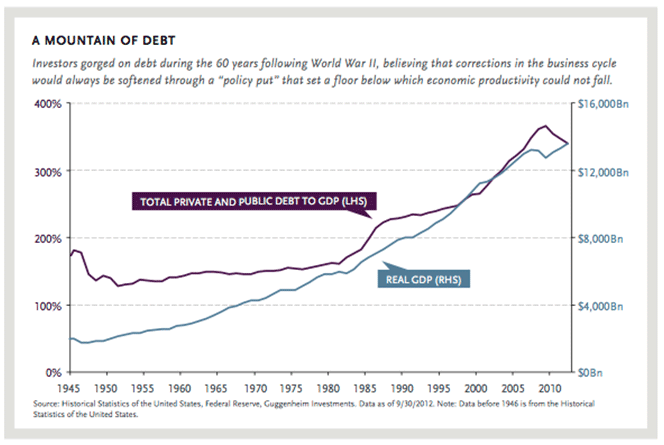
The calamity in the financial system in 2007 and 2008 signaled the beginning of the unraveling of the global debt supercycle. The Keynesian model dictated that the best way to fix the problem was to run large deficits and increase the money supply. Keynes had based his prescriptions for this type of action on the early mismanagement of the Great Depression which he felt had prolonged the losses and hardship during that time. As is the case with most groundbreaking philosophies, Keynes’ disciples carried his views much further than could have been imagined during the period in which the master lived.
The Depression My Father Knew
Keynes viewed governments’ attempts at belt-tightening during the Great Depression as ill-timed. Although President Roosevelt invested in massive public works projects under the New Deal starting in 1933, almost four years into the crisis, the U.S. government maintained a policy of attempting to balance the budget as the depression raged on. Keynes’s response was: “The boom, not the slump, is the right time for austerity at the Treasury.” The other problem, according to Keynes, was that the Federal Reserve’s attempts to lower real interest rates and inject cash into the system were too modest and too late to avoid what he referred to as a liquidity trap, leading people to hoard cash instead of consuming.
To illustrate the dynamics of the liquidity trap Keynes cleverly invoked the analogy of “pushing on a string.” He said that at some point, attempting to stimulate demand by easing credit conditions is like trying to push a string that is tied to an object you want to move. Whereas you can easily pull something toward you by the string to which an object is tied (raising interest rates to slow growth), attempting to carry out the opposite by reversed means (lowering interest rates to try to induce lending to otherwise unwilling borrowers) is not always successful. This is especially true when the rate of inflation becomes so low that it becomes impossible to set interest rates below it.
This Time It’s Different
What sets the current downturn apart from any other since the Great Depression is that, for the first time since the 1930s, we have had severe asset deflation (declining real prices) in the face of relative price stability. Periods of asset deflation occurred between the 1960s and 1990s, but nominal prices were supported by rising inflation levels. Against the backdrop of a rising price level, nominal asset prices remained stable or continued to increase as real asset prices declined. This protected asset-based lenders from severe losses resulting from declining nominal prices.
During the 2008 crisis, inflation levels were close to zero and unable to offset falling real asset values to stabilize nominal prices. This caused a debt deflation spiral to take hold as nominal prices fell. In contrast to the Great Depression, policymakers took extreme measures in 2008 to prevent a total collapse of the financial system and head off a deflationary spiral like that experienced in the 1930s. These policies included sharply increasing the money supply and engaging in an unprecedented amount of deficit spending.
In many ways the swift policy action proved highly effective. Instead of the 25 percent unemployment seen in the 1930s, joblessness reached only 10 percent. While unemployment now stands at roughly eight percent, if one uses the labor force participation rate from 2008, the level is still higher than 11 percent. Although there was a 3.5 percent decline in the price level between July and December of 2008, policymakers immediately tackled and reversed the deflationary spiral. This compares with the Great Depression, when between 1929 and 1933 the general price level declined by 25 percent.
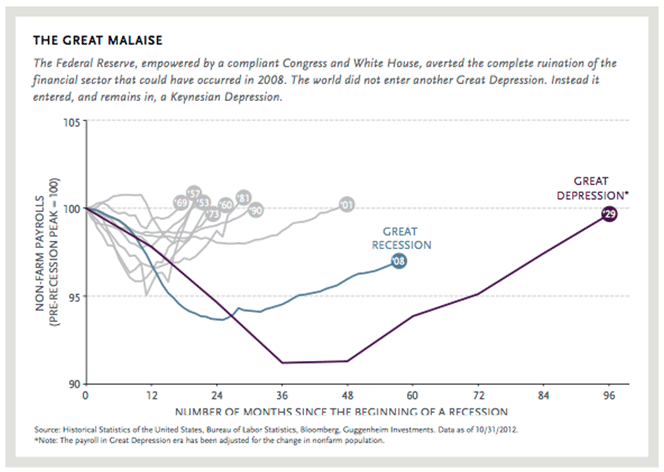
The Aftermath
Though some may be cheered by the relative policy successes this time around, at the current trajectory it will still take almost as long for total employment to fully recover as it did in the 1930s. While job loss was not as severe this time, the recovery in job creation has been much slower. Although nominal and real gross domestic production have returned to new highs on a per capita basis, we are still below 2007 levels. In the same way the Great Depression and the depressions before it lasted eight to 10 years, we will likely continue to see constrained economic growth until 2015-2016 (roughly nine years after U.S. home prices began to slide). Only then will the excess inventory in the real estate market be absorbed, allowing the plumbing of the financial system to function, and supporting an increase in the economic growth rate.
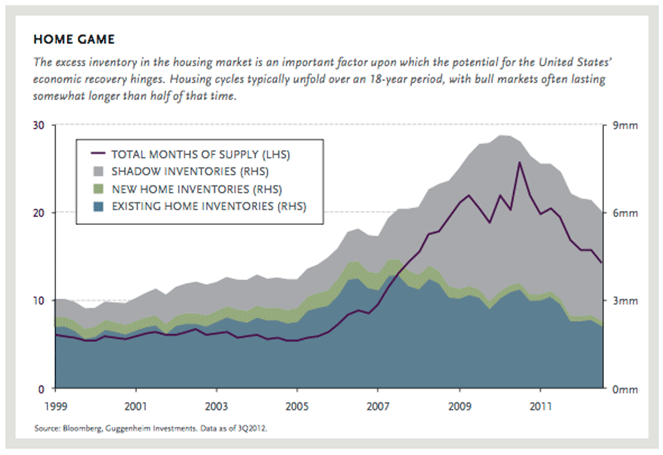
At what cost did we attain this “success”? Like any strong medicine, the policies pursued since 2008 have had, and are continuing to have, unintended side effects. The most glaring feature of today’s global landscape is that governments around the world have exhausted their capacity to borrow money and have turned to their central banks to provide unlimited credit. In the United States, it has taken an average annual deficit of $1.2 trillion and multiple rounds of quantitative easing just to keep the economy growing at a subpar rate since 2009.
In their 2009 book, This Time It’s Different: Eight Centuries of Financial Folly, the economists Carmen Reinhart and Kenneth Rogoff catalogue more than 250 financial crises and conclude that the U.S. cannot reasonably expect to circumvent the outcome that has befallen all overleveraged nations. In the authors’ words:
...Highly leveraged economies, particularly those in which continual rollover of short-term debt is sustained only by confidence in relatively illiquid underlying assets, seldom survive forever, particularly if leverage continues to grow unchecked.
Sovereign powers saddled with debt loads as large as those of the U.S., Europe, and Japan today are jeopardizing their long-term economic wellbeing.
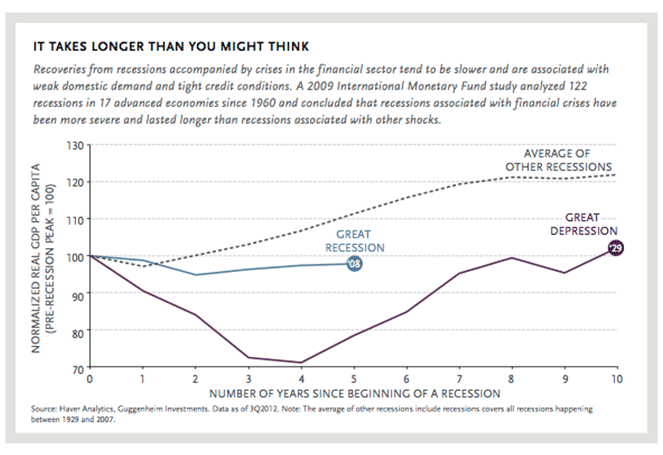
In an October 2012 whitepaper, Reinhart and Rogoff re-emphasized their findings that the U.S. cannot expect to quickly emerge from what occurred in 2008. They point out that 2008 was the first systemic crisis in the U.S. since the 1930s so the consequences have been much more significant than fall-outs from normal recessions.
What Comes Next?
The most important question for investors concerns how public sector debt levels, which have risen exponentially over the past half-decade, will ultimately be discharged. As Reinhart and Rogoff discuss, there are three options to reducing debt levels. The first is restructuring, also known as default. For obvious reasons this is painful and typically avoided except under the most dire circumstances. Governments can also pursue structural reform, which in today’s case would mean greater austerity. Implementation of this would stand in stark opposition to Keynes’s recommendation that the fiscal and monetary spigots be kept open during hard times. Although tightening is arguably the best long-term path, it appears unlikely that it will be the primary policy of choice in the near future. The third method, toward which I see global central bankers drifting, is to keep interest rates artificially low and permit increasing levels of inflation in the economy.
Pushing down the cost of borrowing and allowing the price level to rise is known as financial repression. The real value of debtors’ obligations is reduced by financially repressive policies. Keynes warned of the dangers of inflation in his early work, The Economic Consequences of the Peace, which presciently criticized the harshness of the Treaty of Versailles:
...By a continuing process of inflation, governments can confiscate, secretly and unobserved, an important part of the wealth of their citizens ... As inflation proceeds and the real value of the currency fluctuates wildly, all permanent relations between debtors and creditors, which form the ultimate foundation of capitalism, become so utterly disordered as to be almost meaningless.
Keynes re-iterated his views in the mid-1940s when he visited the United States and saw programs that were touted as Keynesian although he viewed them as primarily inflationary.
Financial repression is nothing new. Between the 1940s and the early 1980s, the United States reduced its national debt from 140 percent of GDP to just 30 percent while continuing to run sizable deficits. The difference between then and now is the magnitude of the debt mountain on the Federal Reserve’s balance sheet that will need to be eroded. A subtle shift has begun in which policymakers are starting to think of inflation as a policy tool rather than the byproduct of their actions. Despite Keynes’ warnings, it appears that higher inflation will continue to be the monetary tool of choice for central bankers tasked with cleaning up sovereign balance sheets.
Investment Implications
The long-term downside of mounting inflationary pressure will ultimately accrue to bondholders and income-oriented investors. The case can be made that we are marching headlong into a generational bear-market for bonds. During the next decade, holders of Treasury and agency securities will likely realize negative real returns. Despite this, these assets continue to trade at extremely rich valuations. Exactly when the market will awaken to this anomaly in securities pricing remains to be determined. The analogy I would use for the current interest rate environment is that of a balloon being held underwater. When the Fed withdraws from the market and allows interest rates to find their economic level, the balloon will inevitably ascend.
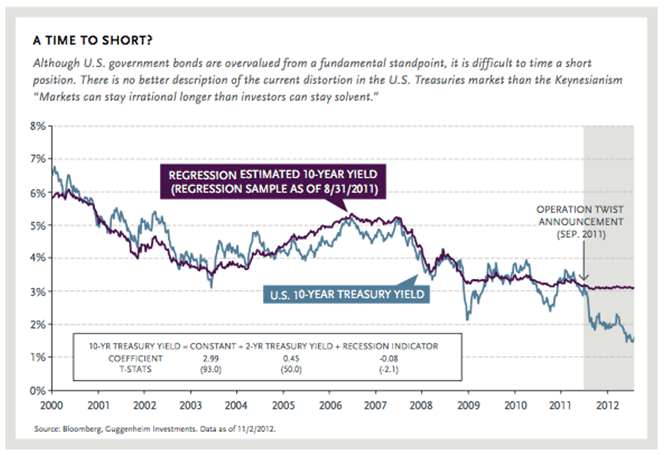
If investors need to stay in fixed-income assets, they should consider transitioning into shorter-duration credit and floating-rate products like bank loans and asset-backed securities. If duration targeting is a concern for liability-matching purposes, adjustable-rate assets can be barbelled with long-duration securities like corporate bonds or long duration agency mortgage securities. Equities and risk assets are likely to rise as the money supply grows.
Gold, as I discussed in my October 2012 Market Perspectives, “Return to Bretton Woods,” has significant upside potentially and should be considered for inclusion in any portfolio designed to preserve or grow wealth over the long-term. Depending on the scale of the current round of quantitative easing and the decline in confidence in fiat currencies, the price of an ounce of gold could easily exceed $2,500 within a relatively short time frame and could ultimately trade much higher.
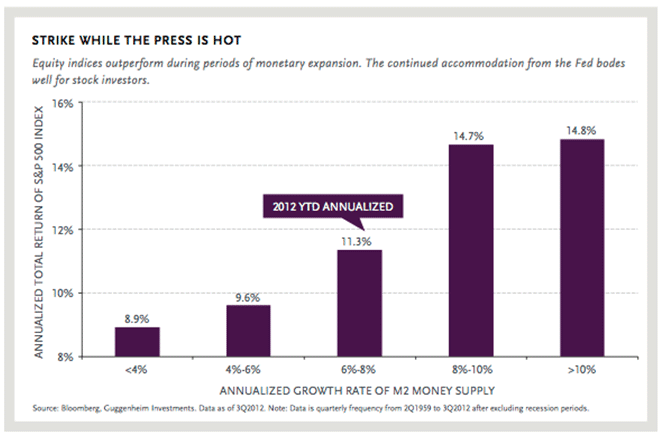
The World is Waiting
The Great Depression brought about the Keynesian Revolution, complete with new analytical tools and economic programs that have been relied upon for decades. The efficacy of these tools and programs has slowly been eroded over the years as the accumulation of policy actions has reduced the flexibility to deal with crises as we reach budget constraints and stretch the Fed’s balance sheet beyond anything previously imagined. Nations have exceeded their ability to finance themselves without relying on their central banks as lenders of last resort and increasingly large doses of monetary policy are required just to keep the economy expanding at a subpar pace. Some have referred to this as reaching the Keynesian endpoint.
Keynes would barely recognize where we now find ourselves. In this ultra loose policy environment we are limited by our Keynesian toolkit. Today, the world is waiting for someone to come forward and explain how we are going to get out of our current circumstances without suffering the unintended consequences created by so-called Keynesian policies.
Early in his life, Abraham Lincoln wrote that he regretted not having been present during the founding of the nation because that was when all the positions in the pantheon of great American leaders were filled. By resolving America’s Imperial Crisis through the Civil War and the abolishment of slavery, Lincoln would go on to join those lofty ranks himself. Much like that crisis needed Lincoln, the current crisis needs someone who can identify new tools to resolve the present economic crisis. Until then we are condemned to a path which leads to further currency debasement and the erosion of purchasing power, with the result being a massive transfer of wealth from creditor to debtor. Without a new economic paradigm, the deleterious consequences of the current misguided policies are a foregone conclusion. It would seem my Dad could hardly have been more correct when he described the next depression from behind the wheel of his 1969 Buick.
---------------------------------------------------------------------------------------------------------------------------------------
No comments:
Post a Comment